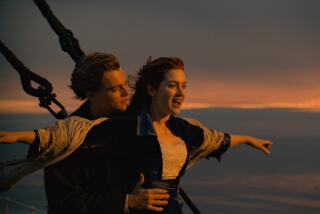Cameron goes from ‘Titanic’ to the Bismarck
- Share via
The story of the ill-fated German warship Bismarck took hold of filmmaker James Cameron as a youngster, when he watched the 1960 British movie “Sink the Bismarck.”
He saw it again recently and was unimpressed. “Not that great a film. The special effects were terrible,” said Cameron, who proved in “Titanic” and “The Abyss” that he knows a thing or two about the subject.
But his fascination with the Bismarck was unabated and he responded to it in grand manner: with a deep-sea excursion detailed in a new Discovery Channel documentary.
“James Cameron’s Expedition: Bismarck,” airing at 9 p.m. Sunday, is a triumph of technology, offering crystal-clear pictures of the ship that tumbled 16,000 feet below the Atlantic’s surface.
Through interviews with experts and survivors, documentary footage and animation, the film re-creates the Bismarck’s role in Nazi Germany, the massive threat it represented to Britain and its final battle.
“Bismarck emerged from the whole madness of World War II as a ship of legend,” Cameron said in an interview, comparing its place in history -- and in storytelling -- to that of the doomed passenger ship Titanic.
Preserved in their dark and distant ocean cradles, the ships provide the opportunity to visit a “dimension that’s almost outside of time, where nothing changes, or changes very slowly,” Cameron said.
The documentary is as much detective story as adventure, piecing together evidence to determine how the Bismarck went down. Was it pounded into oblivion as the British contend, or scuttled by a German crew under relentless attack?
The 42,000-ton Bismarck, the mightiest warship in the world when commissioned for Adolf Hitler’s navy in 1940, was both a menace and a malevolent symbol to the British.
Its attacks on convoys of food and equipment from North America intended to sustain Britain were devastating. Then the Bismarck sank Britain’s great battle cruiser, the Hood, on May 24, 1941. All but three of the Hood’s crew of 1,400 were killed.
“That simultaneously terrified the British and put them in a mode which they probably do better than anybody, which is to knuckle down and do what it takes,” said Cameron, a quick study who consumed history books for the expedition.
On May 27, 1941, a British armada extracted its revenge, bombarding the German warship with shells and torpedoes. Of its more than 2,200-member crew, about 100 survived the attack.
The Bismarck was found in 1989 on the ocean floor off the coast of France by Robert Ballard, who had led the expedition that found the Titanic four years earlier.
“So I’m making a career following Robert Ballard around,” Cameron said with a laugh.
Cameron found the Bismarck remarkable, even in defeat.
“It’s a fantasy shipwreck in that here it’s sitting upright, complete on the bottom, with guns still pointed in the positions they were in during battle. Frozen in the steel is the record of that battle, down to every shell fall,” Cameron said.
A detailed re-creation of the battle and an analysis by forensics experts convinced Cameron that the British can take credit for the kill but that the ship’s crew sent it to the bottom.
If Cameron has any qualms about provoking debate, it doesn’t show. He’s relishing the adventures he creates for himself.
“One big thing in my life is trying new things ... and now I’m getting to combine filmmaking with exploration, so I’m happy as a clam. This to me is the perfect crossing point of two big driving vectors in my life.”
More to Read
Only good movies
Get the Indie Focus newsletter, Mark Olsen's weekly guide to the world of cinema.
You may occasionally receive promotional content from the Los Angeles Times.








